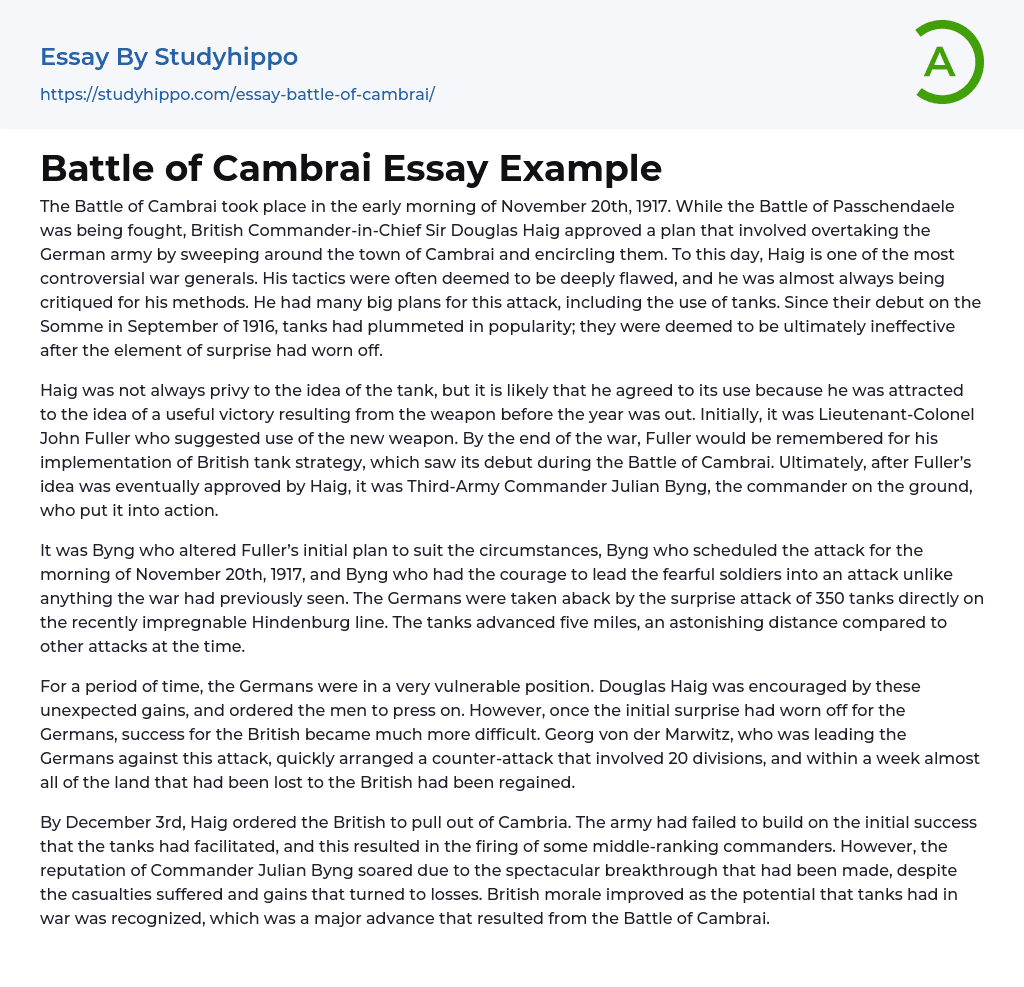The Battle of Cambrai took place in the early morning of November 20th, 1917. While the Battle of Passchendaele was being fought, British Commander-in-Chief Sir Douglas Haig approved a plan that involved overtaking the German army by sweeping around the town of Cambrai and encircling them. To this day, Haig is one of the most controversial war generals. His tactics were often deemed to be deeply flawed, and he was almost always being critiqued for his methods. He had many big plans for this attack, including the use of tanks. Since their debut on the Somme in September of 1916, tanks had plummeted in popularity; they were deemed to be ultimately ineffective after the element of surprise had worn off.
Haig was not always privy to the idea of the tank, but it is likely that he agreed to its u
...se because he was attracted to the idea of a useful victory resulting from the weapon before the year was out. Initially, it was Lieutenant-Colonel John Fuller who suggested use of the new weapon. By the end of the war, Fuller would be remembered for his implementation of British tank strategy, which saw its debut during the Battle of Cambrai. Ultimately, after Fuller’s idea was eventually approved by Haig, it was Third-Army Commander Julian Byng, the commander on the ground, who put it into action.
It was Byng who altered Fuller’s initial plan to suit the circumstances, Byng who scheduled the attack for the morning of November 20th, 1917, and Byng who had the courage to lead the fearful soldiers into an attack unlike anything the war had previously seen. The Germans were taken aback by th
surprise attack of 350 tanks directly on the recently impregnable Hindenburg line. The tanks advanced five miles, an astonishing distance compared to other attacks at the time.
For a period of time, the Germans were in a very vulnerable position. Douglas Haig was encouraged by these unexpected gains, and ordered the men to press on. However, once the initial surprise had worn off for the Germans, success for the British became much more difficult. Georg von der Marwitz, who was leading the Germans against this attack, quickly arranged a counter-attack that involved 20 divisions, and within a week almost all of the land that had been lost to the British had been regained.
By December 3rd, Haig ordered the British to pull out of Cambria. The army had failed to build on the initial success that the tanks had facilitated, and this resulted in the firing of some middle-ranking commanders. However, the reputation of Commander Julian Byng soared due to the spectacular breakthrough that had been made, despite the casualties suffered and gains that turned to losses. British morale improved as the potential that tanks had in war was recognized, which was a major advance that resulted from the Battle of Cambrai.
- Business Law essays
- Contract essays
- Consumer Protection essays
- Property essays
- Ownership essays
- Agreement essays
- Common Law essays
- Contract Law essays
- Justice essays
- Security essays
- Tort Law essays
- United States Constitution essays
- Crime essays
- Lawsuit essays
- Treaty essays
- Family Law essays
- Marijuana Legalization essays
- Constitution essays
- War on Drugs essays
- Court essays
- Jury essays
- Police essays
- Protection essays
- Community Policing essays
- Criminal Law essays
- Judge essays
- Lawyer essays
- Employment Law essays
- Copyright Infringement essays
- Injustice essays
- Intellectual Property essays
- Breach Of Contract essays
- Jurisprudence essays
- Social Injustice essays
- Juvenile Justice essays
- Internet Privacy essays
- Cyber Security essays
- Bill Of Rights essays
- Civil Liberties essays
- First Amendment To The United States Constitution essays
- Fourth Amendment To The United States Constitution essays
- Second amendment essays
- Animal Cruelty essays
- Law Enforcement essays
- Juvenile Justice System essays
- Surveillance essays
- Forensic Science essays
- Crime Prevention essays
- Criminal Justice essays
- Criminology essays




